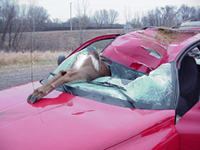Deer-Vehicle Collision Frequency Up 21 Percent in Five Years
 |
BLOOMINGTON, IL - October 2, 2010: While the number of miles driven by U.S. motorists over the past five years has increased just 2 percent, the number of deer-vehicle collisions in this country during that time has grown by ten times that amount.
Using its claims data, State FarmŽ, the nation's leading auto insurer estimates 2.3 million collisions between deer and vehicles occurred in the U.S. during the two-year period between July 1, 2008 and June 30, 2010. That's 21.1 percent more than five years earlier. To put it another way, during your reading of this paragraph, a collision between a deer and vehicle will likely have taken place (they are much more likely during the last three months of the year and in the early evening).
LIKELIHOOD OF DEER-VEHICLE COLLISIONS
For the fourth year in a row, West Virginia tops the list of those states where a driver is most likely to collide with a deer. Using its claims data in conjunction with state licensed driver counts from the Federal Highway Administration*, State Farm calculates the chances of a West Virginia driver striking a deer over the next 12 months at 1 in 42.
Iowa is second on the list. The likelihood of a licensed driver in Iowa striking a deer within the next year is 1 in 67. Michigan (1 in 70) is third. Fourth and fifth on the list are South Dakota (1 in 76) and Montana (1 in 82).
Pennsylvania is sixth, followed by North Dakota and Wisconsin. Arkansas and Minnesota round out the top 10.
The state in which deer-vehicle collisions are least likely is still Hawaii (1 in 13,011). The odds of a Hawaiian driver hitting a deer between now and 12 months from now are roughly equivalent to the odds of finding a pearl in an oyster shell.
U.S. map showing likelihood of deer-vehicle collision by state
Chart listing likelihood of vehicle-deer collision by state
According to the Insurance Institute for Highway Safety, deer-vehic le collisions in the U.S. cause about 200 fatalities each year.
The average property damage cost of these incidents was $3,103, up 1.7 percent from a year ago.
AVOIDING DEER-VEHICLE COLLISIONS
These collisions are more frequent during the deer migration and mating season in October, November and December. The combination of growing deer populations and the displacement of deer habitat caused by urban sprawl are producing increasingly hazardous conditions for motorists and deer.
"State Farm has been committed to auto safety for several decades and that's why we want to call attention to potential hazards like this one," said Laurette Stiles, State Farm Vice President of Strategic Resources. "We hope our updated information will inspire motorists to make safe decisions."
Here are tips on how to reduce the chances that a deer-vehicle collision involving your vehicle will be part of the story we tell in next year's version of this news release:
- Be aware of posted deer crossing signs. These are placed in active deer crossing areas.
- Remember that deer are most active between 6 and 9 p.m.
- Use high beam headlamps as much as possible at night to illuminate the areas from which deer will enter roadways.
- Keep in mind that deer generally travel in herds €“ if you see one, there is a strong possibility others are nearby.
- Do not rely on car-mounted deer whistles.
- If a deer collision seems inevitable, attempting to swerve out of the way could cause you to lose control of your vehicle or place you in the path of an oncoming vehicle.
*State Farm has changed its methodology for computing the likelihood of deer-vehicle collisions, using number of licensed drivers instead of number of registered vehicles, thereby computing the likelihood a driver will collide with a deer over the next 12 months rather than the likelihood a vehicle will collide with a deer over the next 12 months.
About State Farm
State Farm insures more cars and homes than any other insurer in the U.S., is the leading insurer of watercraft and is also a leading insurer in Canada. Our 17,800 agents and more than 68,000 employees serve 81 million policies and accounts €“ more than 79 million auto, fire, life and health policies in the United States and Canada, and nearly 2 million bank accounts. State Farm Mutual Automobile Insurance Company is the parent of the State Farm family of companies. State Farm is ranked No. 34 on the Fortune 500 list of largest companies.


